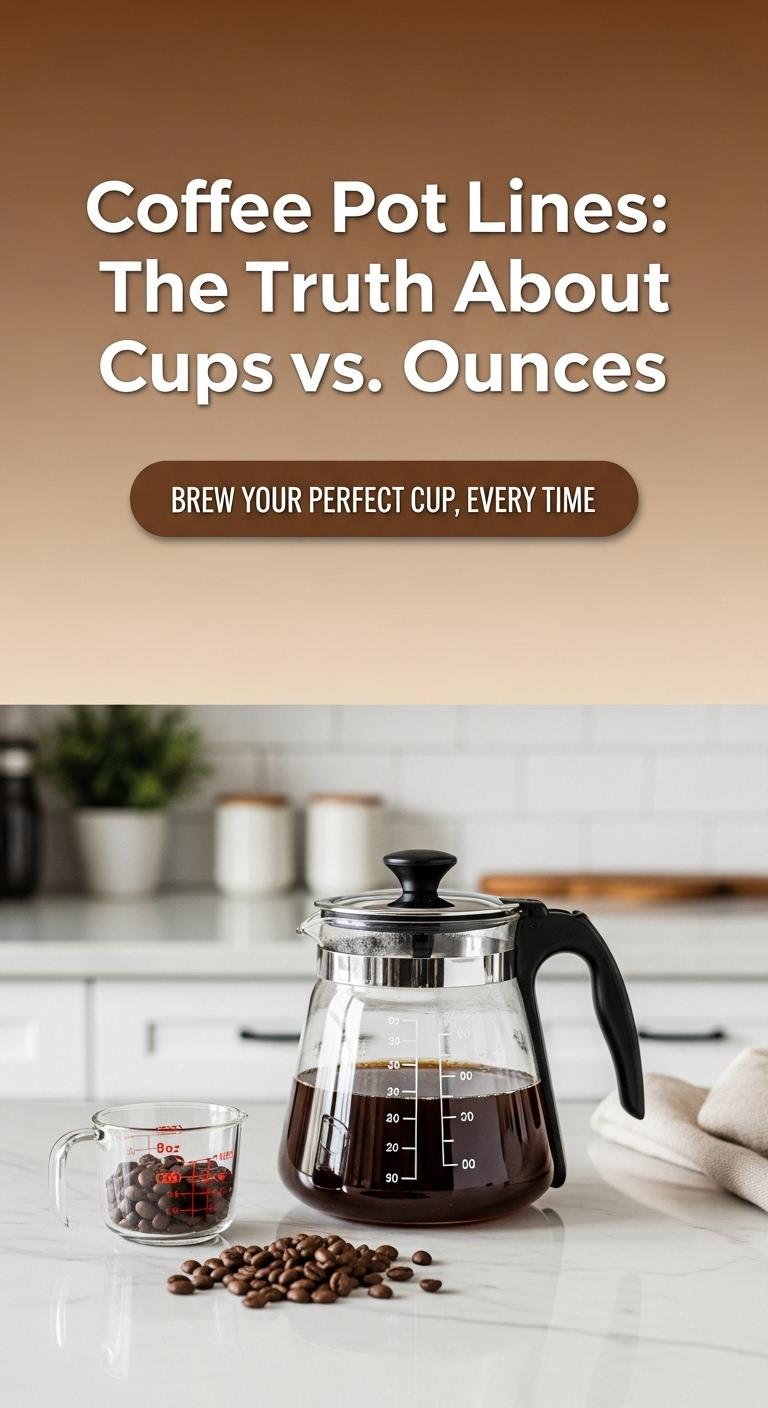As an Amazon Associate CoffeeXplore.com earns from qualifying purchases.
Coffee Pot Lines: The Truth About Cups vs. Ounces
You’ve just poured a fresh pot of coffee, ready to tackle the day. You filled the machine to the “12-cup” line, but as you fill your favorite oversized mug, you realize it only yields two or three full servings. It’s a frustratingly common kitchen mystery: why does a full pot of coffee never seem to match the number of cups it promises? This confusion between the lines on the carafe and your actual mug size leads to inconsistent, often disappointing, brews.
The lines on a coffee pot represent “cups,” but this is a special coffee industry measurement of 5 to 6 fluid ounces, not the standard 8-ounce U.S. measuring cup. This convention is used by manufacturers to guide you toward a balanced coffee-to-water ratio for optimal brew strength.
Leveraging extensive analysis of manufacturer standards and brewing best practices, this guide will completely demystify the numbers and lines on your coffee pot. We’ll unpack why this confusing standard exists and provide clear, practical instructions to help you finally brew the perfect, consistent pot of coffee every single time. Forget the guesswork; it’s time to understand exactly what you’re brewing.
Key Facts
- A “Coffee Cup” Isn’t a Standard Cup: The single most important fact is that the “cup” markings on a coffee maker carafe are a unit of serving, typically 5 to 6 fluid ounces, not the 8 fluid ounces of a standard US measuring cup.
- Designed for Brew Strength: Manufacturers use this smaller “cup” measurement to simplify brewing. It’s designed to align with the common recommendation of one to two tablespoons of grounds per “cup” to achieve a well-balanced, flavorful brew.
- Industry Standard Is 6 Ounces: The Specialty Coffee Association (SCA), a global leader in coffee standards, defines a “cup” for brewing purposes as 6 ounces (or 180 ml) of water.
- A 12-Cup Pot Holds 72 Ounces: Following the 6-ounce standard, a 12-cup coffee pot is designed to hold 72 fluid ounces of water, which is equivalent to nine standard 8-ounce measuring cups, not twelve.
- Weight is the Gold Standard: For ultimate consistency, coffee experts use the “golden ratio.” Evidence suggests aiming for a coffee-to-water ratio of 1:16 to 1:18 by weight (e.g., 55 grams of coffee per 1 liter of water) produces the most reliable results.
Coffee Pot Lines: Are They Ounces or Cups? The Simple Truth
The lines on a coffee pot represent “cups,” but a coffee pot cup is typically 5 to 6 fluid ounces, not the standard 8-ounce measuring cup. This is a manufacturer convention for serving size, not a standard unit of volume. Ever filled your 12-cup coffee maker only to get a few large mugs of coffee? Here’s why. The core of the confusion lies in the difference between a “coffee pot cup” and the measuring cup in your kitchen cabinet.

This discrepancy isn’t an error; it’s a deliberate choice by manufacturers to guide your brewing. Let’s break down the key distinction:
- Coffee Pot Markings: These lines indicate servings, with each “cup” being about 6 fluid ounces of water.
- Standard Measuring Cup: This is a volumetric measurement tool where one cup is legally defined as 8 fluid ounces.
- Your Drinking Mug: This can vary wildly, from 8 ounces to 20 ounces or more.
Once you realize the markings on your coffee pot are for smaller, 6-ounce servings, the math starts to make sense, and you can take control of your brew.
So, What is a “Coffee Pot Cup”?
A “coffee pot cup” is a non-standard serving size, usually 6 ounces. However, some brands like Mr. Coffee define it as 5 ounces. This is the crucial piece of information that bridges the gap between the number on the carafe and the amount of coffee you actually get.
Quick Fact: The Specialty Coffee Association (SCA), a leader in coffee standards, defines a ‘cup’ for brewing as 6 oz of water. This standard is widely adopted and is the most common measurement you’ll find.
To see how these “cups” stack up, here’s a simple comparison:
| Measurement Type | Volume in Fluid Ounces (oz) | Primary Use |
|---|---|---|
| Standard U.S. Cup | 8 oz | Baking, Cooking, Volumetric Measurement |
| Common Coffee Pot “Cup” | 6 oz | Drip Coffee Maker Serving Size |
| Mr. Coffee “Cup” | 5 oz | Specific Manufacturer Serving Size |
Understanding that your machine is working with these smaller 5 or 6-ounce increments is the first step to brewing with intention and precision.
Why Don’t Coffee Makers Use a Standard 8-Ounce Cup?
Coffee makers use a smaller 5-6 ounce “cup” to guide users toward an optimal coffee-to-water ratio for a balanced brew strength, treating it as a “serving size” rather than a standard volumetric measurement. If manufacturers used a true 8-ounce cup marking, most people would end up with weak, under-extracted coffee.
The entire system is designed around achieving a good-tasting final product with simple instructions. By defining a “cup” as 6 ounces, manufacturers make it easy for you to follow the “one scoop per cup” rule and get a brew that’s neither watery nor sludgy.
Think of the markings as ‘servings’ rather than ‘cups,’ and the logic becomes much clearer. Here is the cause-and-effect relationship that manufacturers are trying to help you avoid:
- Using 8 oz of water per “cup” mark… → with the standard recommendation of one tablespoon of grounds…
- Results in a weaker brew… → because the coffee-to-water ratio is diluted, leading to under-extraction and a sour or bland taste.
- Leads to user frustration… → because the coffee doesn’t taste right and the “cup” count feels misleading.
By standardizing around a 6-ounce serving, they create a more foolproof system for the average home brewer who measures by volume with scoops, not by weight with a scale.
How to Brew the Perfect Pot: Practical Measurement Guide
For a balanced brew, use 1 to 2 tablespoons of ground coffee for every 6 ounces of water (one “coffee pot cup”). For ultimate precision, use a kitchen scale and aim for a 1:16 to 1:18 coffee-to-water ratio by weight. Now that you understand the “why,” you can focus on the “how.” Ditching the confusion and brewing great coffee is easy when you follow a clear process. Ready to ditch the guesswork? Weighing your coffee is the single best way to make cafe-quality coffee at home, every single time.
Here is a step-by-step guide to measuring for a perfect pot, from simple to expert methods.

- Measure Your Water Correctly. Use the markings on your coffee maker’s carafe or water reservoir. If you want to brew to the “8” line, fill the water to that mark. This will give you 48 ounces of water (8 cups x 6 oz).
- Measure Your Coffee by Volume (The Good Method). The most common method is using a tablespoon or a coffee scoop. The general rule is one to two level tablespoons of ground coffee for every “cup” mark on your pot. Use one tablespoon for a milder brew and two for a stronger one.
- Measure Your Coffee by Weight (The Best Method). For unparalleled consistency, use a digital kitchen scale. This removes all the variables of grind size and density. The professional standard, known as the “golden ratio,” is between 1:16 and 1:18 (one gram of coffee for every 16-18 grams/ml of water). Well-established research indicates this ratio produces optimal extraction.
Here is a quick reference table for brewing using the common “1.5 tablespoons per 6 oz cup” rule:
| “Cups” on Pot | Water to Use | Ground Coffee (Tablespoons) |
|---|---|---|
| 4 Cups | 24 oz | 6 tbsp |
| 6 Cups | 36 oz | 9 tbsp |
| 8 Cups | 48 oz | 12 tbsp |
| 10 Cups | 60 oz | 15 tbsp |
| 12 Cups | 72 oz | 18 tbsp |
Example: Brewing a Full 12-Cup Pot
A 12-cup coffee pot typically holds 72 ounces of water (12 x 6 oz), requires 12-24 tablespoons of coffee, and yields about 60-65 ounces of brewed coffee after water absorption. Let’s apply these principles to the most common coffee maker size to see how it works in practice.
A critical factor to remember is that you will not get out the same amount of liquid that you put in. During the brewing process, coffee grounds absorb roughly twice their weight in water, and a small amount is also lost to steam and evaporation. This is why your final yield is always less than your starting water volume.
Here’s the math for a full 12-cup pot using a strong 2 tbsp/cup ratio:
| Input / Output | Measurement | Calculation |
|---|---|---|
| Water Input | 72 fluid ounces | 12 “cups” x 6 oz/cup |
| Coffee Grounds | ~24 Tablespoons | 12 “cups” x 2 tbsp/cup |
| Expected Coffee Yield | ~60-65 fluid ounces | 72 oz minus water loss |
Understanding this process manages your expectations and clarifies that a “12-cup” pot will realistically yield about seven to eight standard 8-ounce mugs of coffee.
To truly master your brew and eliminate all guesswork, using a digital kitchen scale is a game-changer. It ensures you use the exact same amount of coffee and water every time, leading to perfectly repeatable results.
FAQs About Coffee Pot Measurements
Here are direct answers to the most common questions people have about coffee pot measurements, helping to clear up any lingering confusion.
Are the lines on a coffee pot carafe in oz?
No, the lines on a coffee pot carafe almost always indicate “cups,” which are typically 5 or 6 ounces each, not fluid ounces. This is the most common point of confusion. You should always assume the numbers refer to these smaller, non-standard “coffee cups” unless your machine specifically states otherwise.
How many ounces is the 10 line on a coffee pot?
The “10” line on a coffee pot represents 10 “cups.” This equals 60 ounces if your maker uses the 6-ounce standard (10 x 6), or 50 ounces if it uses the 5-ounce standard (10 x 5). To know for sure, you can test it by pouring water from a measuring cup into your carafe, but 60 ounces is the most common volume for a 10-cup machine.
Is a 12-cup coffee maker actually 12 standard cups?
No. A 12-cup coffee maker makes 72 ounces of coffee (12 x 6 oz), which is equivalent to nine standard 8-ounce measuring cups. This is why a full 12-cup pot doesn’t yield twelve large mugs of coffee. It’s designed to produce twelve smaller 6-ounce servings.
How many tablespoons of coffee should I use per “cup” on my machine?
The general rule is to use 1 to 2 level tablespoons of ground coffee for every “cup” mark on your coffee pot, which corresponds to about 6 ounces of water. Start with 1.5 tablespoons per cup and adjust to your personal taste. For a stronger brew, use 2 tablespoons; for a milder one, use 1.
Final Summary: Brew Coffee Confidently by Understanding Ounces, Not “Cups”
The frustrating mystery of the coffee pot measurement is, in the end, a simple matter of translation. By understanding that your coffee maker isn’t speaking in standard 8-ounce cups but in smaller, 6-ounce servings, you reclaim control over your morning ritual. This isn’t a design flaw but a deliberate system created to help you easily achieve a balanced brew without complex calculations. Now you are equipped with the knowledge to look at the lines on your carafe not as a source of confusion, but as a reliable guide to a delicious and consistent pot of coffee.
Here are the most critical takeaways to remember:
- Think 6 Ounces: When you see a “cup” line on your coffee pot, think “6 fluid ounces.”
- It’s a Serving, Not a Measurement: The markings are for serving sizes designed to taste good with a standard scoop of coffee.
- Use 1-2 Tablespoons Per Mark: This is the easiest way to brew by volume and get a great-tasting cup.
- Weigh for Perfection: For the absolute best and most consistent results, use a kitchen scale and a 1:16 coffee-to-water ratio.
Go ahead, check your coffee pot and a measuring cup. Take these insights and brew your best, most consistent pot of coffee tomorrow morning
Last update on 2025-12-15 / Affiliate links / Images from Amazon Product Advertising API

